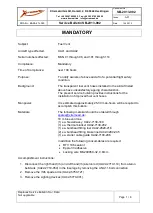
— 28 —
cial spot remover that is labeled for use on polyester. Such cleaning agents are available at the
supermarket or drug store, or you may order a cleaning solution from Wills Wing through your
dealer.
A note about cables and cable maintenance:
The cables which support the glider’s airframe are critical components of the glider’s structure, and
must be maintained in an air worthy condition. It is a general practice in the design of aircraft struc-
tures to design to an ultimate strength of 1.5 times the highest expected load in normal service. Hang
glider cables, like other structural components on the glider, are typically designed with a structural
safety factor of only about 50% above the expected maximum load. No significant loss in cable
strength can be tolerated.
A cable with even a single broken strand must be replaced before the glider is flown again. A cable
which has been bent sharply enough to have taken a permanent set (will not lie flat in a straight line
when all tension is removed) must also be replaced immediately. If it is not, subsequent tensioning
and de-tensioning of the cable will induce fatigue, and the cable will fail. In tests we have conducted,
a cable bent one time to 90 degrees, and then loaded to the equivalent of a normal flight load 100
times (corresponding to 100 or fewer flights), failed at only 56% of its original strength.
Some degree of fatigue due to repeated bending of cables is almost unavoidable in an aircraft that
is assembled and disassembled with every flight. Bottom side wires are subject to the highest loads
in flight, and are therefore the most critical. This is why we recommend that these wires be replaced
annually, even if there is no known damage. The requirement for immediate replacement of a cable
known to have been bent or otherwise damaged supercedes this annual replacement requirement.
Replacement cables should always be obtained from the factory, or, if not from the factory, from a
reliable source known to use proper fabrication procedures. An improperly made cable may appear
perfectly OK on visual inspection, but could fail in flight at a load much below the intended design
strength of the cable. Even if the replacement cable is obtained from the factory, it should be checked
carefully for length against the cable it is replacing, and inspected carefully before being installed.
Removing The Sail From The Airframe And Re-installing
Many maintenance and repair procedures will require the removal of the sail from the frame. Please
follow these instructions when removing and re-installing the sail. Please read all the instructions for
each operation before beginning.
Sail removal
You will need an unobstructed area six feet by thirty feet. Make sure the surface is clean. If it is abra-
sive, like rough concrete, you should either put down a protective tarp or be extremely careful not to
scrape your sail.
1. Lay the glider on its back, unzip and remove the glider bag and put the battens aside. Remove the
control bar bag.
2. Remove the screws that secure the sail at the nose. Spread the wings slightly, undo the velcro tabs
inside the rear ends of the leading edges and then dismount the sail from the rear leading edges.
Summary of Contents for Alpha 180
Page 1: ...Alpha 180 and 210 Owner Service Manual June 2015...
Page 2: ......
Page 4: ......
Page 6: ......
Page 55: ...49...












































